100 Proofs The Israelites Were White - 21-30
21) The Israelite Conquests and Migrations to Greece
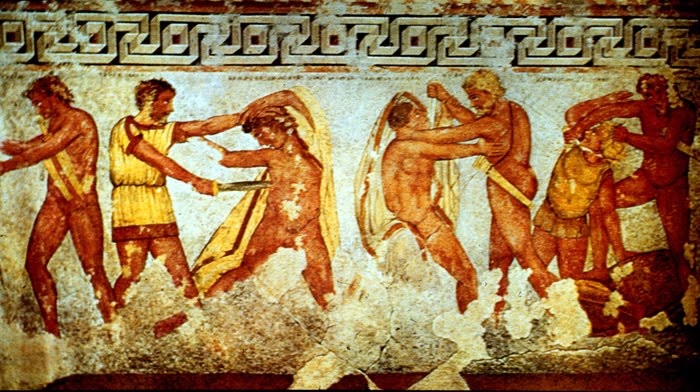
The earliest Greek writers describe the Hellenes (Greeks) as four distinct tribes, each with their own Greek dialects and subdialects: the Ionians, Aeolians, Danaans, and Dorians. Later Greek tribes came from these four. The Ionians were Javan, from Japheth, whilst the other three were Israelites. Most likely, the Aeolians came from the Israelite Phoenicians (which we’ll cover in the next Proof).
Diodorus Siculus, the first-century BC Greek historian, gave an account of the Hebrew Exodus from Egypt but from the Egyptian point of view: “The aliens [Israelites] were driven from the country [Egypt], and the most outstanding and active among them banded together and, as some say, were cast ashore in Greece and certain other regions; their leaders were notable men, chief among them being Danaus and Cadmus. But the greater number were driven into what is now called Judaea…The colony was headed by a man called Moses, outstanding both for his wisdom and for his courage” (Diodorus Siculus, Library of History, 40.3.1-3).
Danaus was known as “the Egyptian” and was said to have led the Danaans to Greece. No doubt the name Danaans came from the tribe of Dan, but the historian Homer also called them Acheans and the Argives. That’s because the Danaans initially colonized the Achea region and its major city, Argos. As Diodorus explains: “They say also that those who set forth with Danaus, likewise from Egypt, settled what is practically the oldest city in Greece, Argos” (Diodorus Siculus, Library of History, 1.2). Danaus and the Danaans would have arrived around the time of the Exodus in 1450 BC when Greece was primarily inhabited by the Ionians (Japhetites). On the other hand, Cadmus was called “the Phoenician,” although the timing is slightly off as the Phoenicians came later after the Israelites had conquered Canaan. Nevertheless, this shows that people knew that the Danaans and Phoenicians were related peoples and had a common origin in the Exodus.
Modern archaeologists and historians obfuscate and hide the name Danaans and describe their settlements as the “Mycenaean Civilization,” after their ancient capital city Mycenae. This is were King Agamemnon ruled and formed a coalition to attack the Trojans. Mycenae was destroyed in ancient times by the invading Dorians who arrived in the 12th century BC. But modern historians claim no one knows what happened to the “Mycenaean Civilization” or caused its collapse, but by reading the classic history, it’s clear that the cause was Dorians’ arrival.
The Dorians were Israelites who arrived in Greece three generations after the Trojan war. They originated from the sea port Dor in Manasseh’s territory, hence the name Dorians, which means people of Dor. Many modern historians deceptively claim that the Dorians invaded the Peloponnese from the north, where they largely supplanted the Danaans and took over their cities such as Corinth and Sparta. But this is sheer conjecture. We need to return to Homer and his descriptions of the Greek world of the 12th century BC. Homer identifies the Dorians as one of the tribes present on the island of Crete, not as a tribe approaching from the north. The Dorians are said to have invaded Greece from the seas, and Crete was the natural layover point between the sea port of Dor and Greece. The Dorians could more easily launch an invasion from Crete.
Furthermore, historian Flavius Josephus in Book 12 of his Antiquities records a letter that the king of Sparta sent to the high priest at Jerusalem, probably around 160 BC: “Areus, king of the Lacedemonians, to Onias, sends greetings. We have met with a certain writing, whereby we have discovered that both the Judaeans and the Lacedemonians are of the same family, and are derived from the kindred of Abraham.” Here we see that the Spartans (Lacedemonians) knew that they were related to the Israelites. King Areus ended the letter thusly: “This letter is four square; and the seal is an eagle, with a dragon in his claws.” The eagle was one the signs of the tribes of Israel.
Previously, Judah had been blessed and assured that: “The scepter shall not depart from Judah, nor a lawgiver from between his feet.” In other words, Judah’s descendants would be kings would would rule the Israelites forever. Judah had twin sons, Perez and Zerah. From the bloodline of Perez came King David, King Solomon, and other kings in the land of Canaan. But those kings did not arise until many centuries after the prophecy, so where were the promised kings during those centuries? They came through Zerah and they were not in the land of Canaan. Zerah’s sons are listed: “The sons of Zerah: Zimri, Ethan, Heman, Kalkol and Darda—five in all”(I Chronicles 2:6).
But once these sons are named, they disappear from the Bible. Around the time of the Exodus from Egypt, Zerah is mentioned and he is with his twin brother, Perez. But only the sons of Perez are present. Meanwhile, in Greek history of the same period, famous kings seem to appear out of nowhere with the same names as the sons of Zerah. A King Dardanus (Dardanus is the Greek version of Darda) arose in the Troad (the west coast of Turkey), where he founded a colony named Dardania. His people were the Dardanians: “Of these children, Dardanus, who was a man who entertained great designs and was the first to make his way across to Asia in a makeshift boat, founded at the outset a city called Dardanus, organized the kingdom which lay about the city which was called Troy at a later time, and called the peoples Dardanians after himself” (Diodorus Siculus, Library of History, 4.75.3).
Darda’s grandson named Tros founded the city of Troy, which he named after himself. The city of Troy and the Trojans became even more prosperous than Dardania and the Dardanians and grew large and wealthy enough to eclipse them. So we can see that the Trojans were Israelites from the tribe of Judah, coming down through Zerah: “To Erichthonius was born a son Tros, who called the people of the land Trojans, after his own name” (Diodorus Siculus, Library of History, 5.48).
We can therefore see why King Solomon is compared for his wisdom to these very kings. Men such as Darda founded great dynasties that have lasted to this day, and they were kings of Judah just like Solomon. So we can fully understand why this comparison is made in our Bible: “For he [Solomon] was wiser than all men; than Ethan the Ezrahite, and Heman, and Chalcol, and Darda, the sons of Mahol: and his fame was in all nations around about” I Kings 4:31 KJV.
The Romans originated from the Trojans. After the sacking of Troy by the Danaan Greeks, a remnant of Trojans fled Greece. They were led by Aeneas, a prince of Troy and cousin of the famous Hector of Troy. Aeneas and his men sailed around the Mediterranean and finally settled in Latium, Italy. Aeneas married the daughter of the King of Latium, and in time, Aeneas became king and founded a dynasty of kings. The fact that the Trojan remnant settled in Latium is the reason the later Roman language was called Latin. Centuries later, a descendant of Aeneas named Romulus founded the city of Rome.
At first, Rome was just another small town. As time passed, Rome became a city, grew stronger, and began to conquer and absorb the surrounding city-states. Eventually, Rome became the Roman Republic. Then came the mighty Roman Empire ruled over by Emperors. Since the Trojans had founded Rome and the Trojans came from Judah through Zerah, the Romans were also the descendants of Judah and thus were Israelites. The history of Aeneas, his journeys, the founding of Rome, and thus the descent of Romans from Trojans is confirmed by Strabo: “The wandering of Aeneas are a traditional fact….” (Strabo, Geography, 3.2.13)
Some of the Dardanians/Trojans also spread to the west of Greece and formed Illyria, whilst others joined with the Danaans and Dorians and formed Macedonia. Many of the Dorians and Danaans settled the coast of Anatolia, although some were forced out when the Ionians spread to those regions. Furthermore, southern Greece was settled by the Greeks (it was called Magna Grecia) and even the islands in the Mediterranean had colonies. Sardinia comes from Shar-Dan in Hebrew meaning “remnant of Dan.” By taking a close look at history, we see that the Israelites spread all over Europe and ruled Europe from an early time, just as the prophecy to Judah had foretold.
22) The Phoenician Colonization of Europe

The Phoenicians arose around the time of the Judges. They were not a defined nation or kingdom; rather, they were a confederation of maritime traders. They originated from the northern tribes of Israel and came primarily from Tyre and Sidon. They founded trading outposts and port cities all over the Mediterranean coastlands. They colonized areas that grew into city-states. The Phoenicians even established great nations such as Carthage.
But this straightforward story of Israelites who took to the seas has been twisted into a deceptive tale by historians. It’s taught that the Phoenicians were not Israelites but evil Canaanites. It’s supposed that they were a separate nation from the Israelites. Most modern Biblical maps draw a separate nation called Phoenicia along the coastline of Israel. If this were true, it would follow logically that the large parts of Europe that were settled by Phoenicians were actually settled by Canaanites. That is what the modern Canaanites want us to believe. However, it’s a complete fabrication. There was no Phoenicia in the Bible. Joshua and the Israelites conquered and occupied the coast of Palestine as far south as Joppe (a port used by King Solomon) and as far north as Sidon. The Israelites drove the Canaanites out of Tyre and the other port cities, but not completely out of Sidon. Therefore, the Phoenicians are Israelites as only Israelites occupied the port cities from whence the Phoenicians came.
But why were these maritime traders called Phoenicians and not Israelites? Phoenician was a Greek geographical and commercial term. Most surviving historical material from this era was written by the Athenians and they lacked full knowledge of the history of Israel. The traders who became known as the Phoenicians dealt in purple dye found in the mollusks of sea snails on the coasts of Israel. They also dyed their sails and clothing purple. The Greeks called them Phoenicians which comes from the Greek word “phoenix” which means purple. From the Greek perspective, these traders were “purple people.”
We know from history that the Phoenicians colonized much of Europe. Their mother city was Tyre, and they had driven all the Canaanites from Tyre. Therefore, all the Phoenician colonies were Israelite. During the Judges period, Tyre became semi-autonomous within the Kingdom of Israel. King Hiram ruled Tyre; nevertheless, he submitted himself to King David. This situation has been used to “prove” that Tyre was not Israelite. But that’s not true. The Tryrians were indeed Israelites, even though they enjoyed some autonomy. Because they were Israelites, the account of Diodorus Siculus about the connection of Cadmus the Phoenician to Danaus the Egyptian, and both of them to Moses and the ancient Israelites in the Exodus represents the truth (although it may not be literally true). The Phoenicians and the Danaan Greeks both came from the Exodus, although they took different geographical paths than the Israelites who crossed the desert with Moses. Nevertheless, they were kin.
Cadmus is said to have founded the city of Thebes in Greece. He is credited by the ancient Greeks themselves with bringing the Hebrew/Phoenician arts and letters to Greece. The Phoenicians colonized parts of Anatolia, Iberia (Spain), and reached as far as the British Isles. Even today, archaeology tells us that the Phoenicians were tin miners and traders in the Mediterranean. Their reach into Europe was massive.
The Phoenician language is the Hebrew language. But whether this script is labeled Phoenician or Hebrew depends on where the ancient tablet or inscription was found. If the artifact were found in Israel, it’s called Hebrew; but artifacts found in Europe are called Phoenician. The anti-Christs do everything they can to separate the Phoenicians from the Israelites. They even claim that Phoenician is a Canaanite language. This is not true. The Canaanites used cuneiform, the language of Aram. This can easily be proven because the Canaanites wrote letters to the Egyptians in cuneiform begging for help during Joshua’s invasion. Only after Joshua’s conquest of the Canaanites did Hebrew become the language used in that region. Once the lies are cleared up about the true identity of the Phoenicians, we clearly see that the Israelites are the ancestors of the Europeans.
23) Paganism Identifies Who the Lost Sheep Are

The ancient Israelites continuously fell away from Yahweh and sank into paganism. God would then punish them and bring them back to His commandments. This cycle repeated again and again until the Israelites grew so unfaithful and corrupt that Yahweh divorced them and allowed them to be conquered and deported. In exile, they forgot Yahweh and became pagans. But as the Lost Sheep Israelites that they were, they could not forget the one true God completely; they projected vague memories of Him and the religion of their ancestors into the paganism they adopted or developed. We find an example of this in the paganism of the Germanic tribes in Europe.
But first, to really understand this phenomenon, we must know about the two Trees in the Garden of Eden. The Tree of Life is Christ and His Adamic race. God is both the root of the Tree (Yahweh) and the branch (Christ). In contrast, the Tree of the Knowledge of Good and Evil is comprised of the fallen angels and their offspring. The serpent represents the leaders of the Tree of Knowledge of Good and Evil. Initially this was the fallen angles and later it included the descendants of Cain. These two Trees are at constant war with each other and will be until the end of time and the final triumph of Christ. In the meantime, the descendants of Cain are constantly trying to wipe out the Tree of Life. They have succeeded in destroying all the branches except for the Israelites, who are the Europeans.
With that background in mind, we can better understand the Germanic pagan literature — recorded in the Eddas — about Odin as an example of what we’re talking about. Odin is the good god and he had a son called Thor. Fighting against them is the evil god Loki and a Midgard Serpent (also called the World Serpent) that is circling the earth. In the end times (called “Ragnarok”) a great battle will take place between Odin and Loki. Thor will return and defeat the serpent. This concept of a mighty serpent standing in opposition to God and mankind is also a theme of the Bible. When we compare the story of Thor defeating the serpent to Revelation 20, we find great similarities. Yahweh as Yahshua returns to battle and destroy the great serpent. Or in other words, Christ defeats and destroys the fallen angles and their descendants, and thus saves His people Israel who are being overrun from all directions by these evil enemies.
The name Loki is a shortened form of Lucifer. In Old Latin, the “c” was always hard, like our “k.” The Latin “c” is always transliterated as the Greek “k,” so Loki/Lucki is short for Luckifer (which is probably where we get the word “lucky” from). In some accounts, Loki had three children: the wolf Fenris; the world-serpent: and Hel. In Scripture, the children of Satan are compared to wolves. Collectively they are the serpent. In many ways, they represent Hell and death, as the devil is said to have the power of death (Hebrews 2:14). So it certainly seems that Loki may have been introduced into Germanic myth in the Christian era.
In addition, the word Odin is cognate with the Hebrew title Adon, or Lord. Odin was a real historical figure who lived around the 3rd century AD. He founded a kingdom in Scandinavia and northwestern Germany, and divided this kingdom amongst his sons when he died. In the ancient Saxon Chronicles, the kings of Sweden, Denmark, Norway, Saxony in Germany, and Anglo-Saxon England all reckoned their genealogy in the number of generations since they had descended from Odin. This same Odin was said to have led his people from Asa, which can be identified as Asia Minor. Very likely, Odin was a tribal king of the Scythians who dwelt along the south coast of the Black Sea. Furthermore, according to Bede, Anglo-Saxon Christians in Britain were bringing the Gospel of Christ to northern Germany even before his time, and at least as early as the 7th century AD, long before the Eddas were set down in writing by Snorri in the 13th century.
Lastly, the Germanic Eddas tell the myth of a great battle between the Aesir gods and the Vanir gods (Odin being one of the Aesirs). It is likely that Roman Asia is the Asa/Aesir of the Eddas. The Aesir may be identified as Scythians who had migrated into northern Europe through Roman Asia from the region of the Pontus. The Vanir may be the Scythians who migrated from the area around Lake Van, which was further east and under the control of the Parthians.
Thus we see that myths and stories (Odin being just one of these) gradually evolved as the Israelites lived longer and longer in exile and farther away from their original homeland and religion. But we can also clearly see how their pagan myths and cosmologies contained distinct remnants of underlying religious truths that echo Scriptural revelation. We can also see how the myths described the historical migrations of our ancestors. In these ways, paganism could actually point to who the Lost Sheep of Israel were.
24) Most Traditional English Names are from Biblical figures
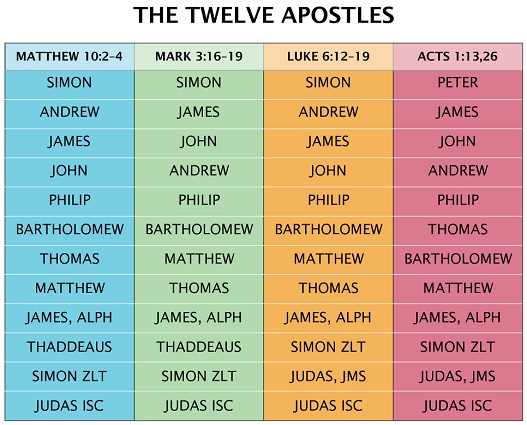
Most European Christian names are drawn from the Bible. We’ve used these names for centuries. Our godly ancestors hoped their children would live up to these names: Biblical names such as Peter, Andrew, James, and John, all apostles of Christ. Where were the apostles and followers Jammal and Shaquisha? Where were Abu, Muhammed, and Wong? Even from our European names, it is obvious that the Bible is naturally tied to the European people, not to other races.
Other male Biblical names include Simon, Philip, Thomas, Matthew, Mark, Paul, Luke, Stephen, Timothy; and from the Old Testament, Adam, Aaron, Benjamin, Dan, Daniel, Jacob, and Jonathan. Female names include Mary, Elizabeth, Anna, Chloe, Hannah, Lydia, Naomi, Rebecca, Rachel, Sarah, Susanne, and many more. And whilst not immediately obvious, many shortened names are derived from longer Biblical names: Eli is short for Elijah; Jack for Jacob; Jerry or Gerard for Jeremiah; Joe or Joey for Joseph; Toby for Tobiah; Zach for Zechariah, and so on. All these names are intrinsic to European culture and heritage. Most would be unknown in Europe had it not been for our preservation of Scripture. Non-Europeans would never have heard of these Biblical names had we not forcefully Christianized them.
Furthermore, many of the names in the New Testament were actually Greek and Roman. Stephen the first martyr was a Greek name, and Luke (Lucas) the Gospel writer was a Roman name. This shows the intrinsic relationship and common culture shared by the Israelites in Judea and the Greek and Roman Israelites. It also shows that the Europeans are the people of the Bible and that the Gospel was spread only to Europeans. It’s in our very names.
25) Peter called the Europeans an Elect Race and a Royal Priesthood
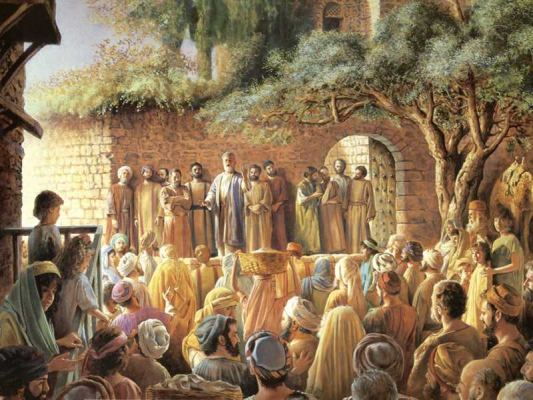
Peter’s wrote his first Epistle to “Pontus, Galatia, Cappadocia, Asia and Bithynia.” These Asia Minor locations were populated by white Romans, Greeks, and Galatians. Peter referred to them collectively as “a chosen generation, a royal priesthood, a holy nation, a peculiar people.” Only the Israelites were chosen to be an elect race and royal priesthood. Peter goes on: “that ye should shew forth the praises of him who hath called you out of darkness into his marvelous light.” Yes, the Israelites had been divorced, cast off, and no longer had a shepherd (and so were in darkness). Yahweh had withdrawn His mercy during the Assyrian deportation, but now in Christ, the Israelites were being shown mercy again. Peter continued: “Which in time past were not a people, but are now the people of God: which had not obtained mercy, but now have obtained mercy.”
Peter is quoting Yahweh’s words to the Israelites through Moses: “Now therefore, if ye will obey my voice indeed, and keep my covenant, then ye shall be a peculiar treasure unto me above all people: for all the earth is mine: And ye shall be unto me a kingdom of priests, and an holy nation. These are the words which thou shalt speak unto the children of Israel” Exodus 19:5-6 KJV. The fact that Peter used these same words shows us that he believed the Europeans were Israelites, the same people Moses had addressed. In this kingdom of priests, every Israelite male was the priest of his household, and collectively the Israelites were a holy nation or people. Yahweh had separated and consecrated them to Himself and specifically commanded them never to intermingle with the other races.
Later in this verse, Peter quoted Hosea Chapter 1. God commanded Hosea to marry a prostitute. She was to be a type of Israel who had played the harlot. Hosea had children with his wife and Hosea was told what to name his child: “Call his name Loammi: for ye are not my people, and I will not be your God.” Thus Yahweh denounced the former kingdom of Israel and foretold that they would lose their identity in their captivity. However, He promised: “Yet the number of the children of Israel shall be as the sand of the sea, which cannot be measured nor numbered; and it shall come to pass, that in the place where it was said unto them, Ye are not my people, there it shall be said unto them, Ye are the sons of the living God.” Here Peter is declaring that the Christians are named after the Living God because Christ is God. Thus he is affirming that the Europeans are fulfilling Hosea’s prophecy. They are the true Israelites who were formerly disowned but are now reunited with God in Christ.
Hosea said more about the great regathering of the children of Israel: “Then shall the children of Judah and the children of Israel be gathered together, and appoint themselves one head, and they shall come up out of the land: for great shall be the day of Jezreel.” This shows that Christianity regathered and reunited Israel and Judah. This reunion can only be the Europeans who became the great and holy nation of Christendom. No other people were cast off by Yahweh and then regathered by Him. Peter is identifying the Europeans as those people. The Europeans and only the Europeans were the lost sheep now reconciled to their God through Christ. None of this applies to any other people.
26) True Israelites divorced and dispersed could never resettle in Palestines

Yahweh warned that the deported Israelites would never resettle Palestine. In fact, Palestine would become a hedge of thorns that would block their path if they tried. Here Yahweh was using thorns as an allegory for the mixed races who would overrun the Middle East and block any Israelites trying to return and rebuild their original homeland.
In Hosea Chapter 2, Yahweh rebuked Israel at length. First, He declared that He was divorcing her: “Plead with your mother, plead: for she is not my wife, neither am I her husband: let her therefore put away her whoredoms out of her sight, and her adulteries from between her breasts.” Here, ancient Israel was the mother, and the Israelites going into deportation were her children. Yahweh then chastised Israel for intermixing with foreign people and Canaanites: “And I will not have mercy upon her children; for they be the children of whoredoms.” In this way, Yahweh showed that He cared only for His own people and not for bastards. This parallels perfectly with Yahshua’s warning against fornication in Revelation Chapter 2: “And I have given her time, in order that she [Israelites] would repent, yet she did not wish to repent from her fornication.” Later the bastards produced through fornication would be destroyed: “… and I shall slay her [fornication Israelites] children with death.”
Hosea Chapter 2 then talks about a sin that is completely overlooked by modern Bible commentators: “For their mother hath played the harlot: she that conceived them hath done shamefully: for she said, I will go after my lovers, that give me my bread and my water, my wool and my flax, mine oil and my drink.” Here Yahweh is angered at not only the intermingling but also the international trade the Israelites had been engaged in. Today we Israelites are doing the exact same thing but on a much larger scale. This has resulted in the roaming vagabond descendants of Cain gaining complete control our countries. The Israelites were intended to be a separate, holy people and that has not changed.
Yahweh proclaimed the punishment: “Therefore, behold, I will hedge up thy way with thorns, and make a wall, that she shall not find her paths.” The Canaanites (who were ace mixed races of ancient Palestine whom the children of Israel were commanded to exterminate) were called pricks and thorns. The children of Israel were warned that if they did not destroy every last one of them, they would become pricks and thorns unto them. Later, in the Gospel, Christ used them as an example onen He said that we will know men by their fruits, nd asked whether men should gather grapes from thorns or figs from thistles.
Next Yahweh declared that the Israelites would try to seek out their former trade partners again: “And she shall follow after her lovers, but she shall not overtake them; and she shall seek them, but shall not find them: then shall she say, I will go and return to my first husband; for then was it better with me than now.” The lovers of ancient Israel were Egypt, Babylonia, Persia, and Assyria, and Yahweh destroyed them all like a vengeful husband. They were never found again. But Yahweh had mercy on His wife the Israelites and redeemed her.
If Yahweh destroyed these peoples and nations, then logically anyone living in those regions now cannot call themselves the Egyptians, Babylonians, Persians, and Assyrians. However, with the knowledge that eventually Arabia overran and totally destroyed all of these nations, we see that this prophecy took a long time to be fulfilled and the result was thorns and thistles destroying the former nations and peoples by intermixing and replacing them. Eventually, a wall of thorns appeared and encompassed the entire Middle East.
Despite their efforts to win back the Middle East, the European Crusades were always doomed to fail. When they tried to reclaim the once Christian Palestine and drive back the Muslim hordes who had overrun it and were encroaching into Europe, they failed. Ultimately they lost out for two reasons: Europe was never unified in its interests, and those who tried to retake the Middle East for Christendom could not overcome the pricks and thorns (the descendants of Cain). But this fulfilled the prophecy that Israel would never resettle the Promised Land. Yahweh had other plans and glories planned for the Israelites in Europe.
27) European Nations, Cities and Settlements still with Hebrew names
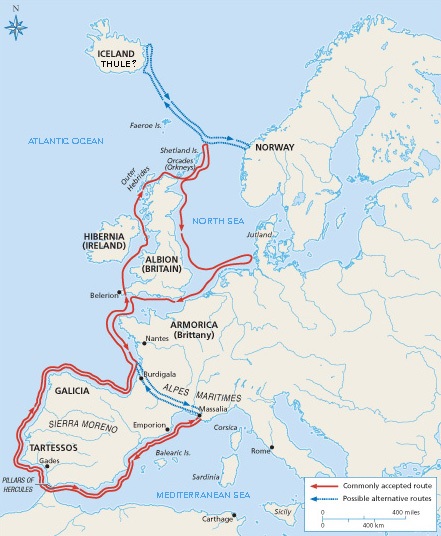
Our Israelite ancestors left traces of the Hebrew language in place-names all across Europe. Denmark, for example, means “the territory of Dan.” The rivers Danube, Don, and Dnieper still bear the name of the tribe of Dan. The Crimea in Ukraine gets its name from the Cimmerians who passed through those lands on their way to Europe. The Welsh still call themselves the Cymri after the Cimmerians, a branch of whom crossed over the North Sea into Britain.
In more ancient times, Spain was called Iberia and Ireland Hibernia. Both names were derived from the Hebrew word Eber which means “other side.” From the coast of Israel, Spain was the other side of the Mediterranean; so was Ireland if you sailed north from Spain. These names were bequeathed by the Israelite maritime Phoenicians with their perspective of “the other side” as they colonized Europe from the time of the Judges. It was only natural that they named places in their Hebrew tongue.
Carthage meant “New City” in Hebrew. Its original name was Qiryah Hadesh and it was an offshoot of the city Tyre, an Israelite port. The Romans corrupted the name to Carthage (the prefix “Car” is the word for a city). In Britain, the Phoenician settlements also had Hebrew names with this prefix, such as Cardiff and Carlisle. At one time, many places in Britain began with “Car,” which was sometimes transliterated as “Caer.”
In Ireland, many place names contain the word Baal, Bel, or Bally, which likely originated from the Hebrew name Baal. After King David and Solomon reigned over Israel, the Israelites began falling into paganism, especially under King Jeroboam in the Northern Kingdom. They began to worship Baal. It should be no surprise that Phoenicians settlers in Europe would bring this paganism with them. Names such as Belfast, Belgrade, Belaire resemble the name Baal. As do Biblical city names such as Baalberith, Baalhazor, Baalhanan, Baalhermon, Baalgad and so on. Some sources claim that the word “Bel” meant “Ford” and that “Bally” is a Gaelic word meaning “town.” But the Hebrew influence is there and those translations may be more than a coincidence.
If we look carefully, we see that our Hebrew ancestors left clues for us in many European place names. It’s no accident that these names are Hebrew. Rather, it proves that the ancient Israelites came to Europe, settled here, and named places after themselves or in their own language. The lasting message of these place names is that Europe was settled by ancient Israelites and we remain the true Israelites today.
28) The Scottish Declaration of Arbroath
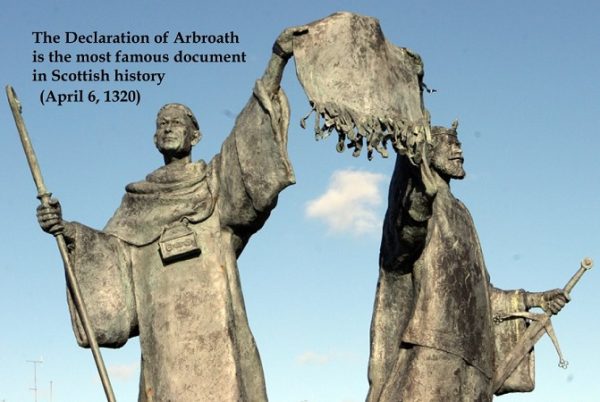
The Scottish Declaration of Arbroath is the most famous document in Scottish history; it declares the Scots to be the descendants of the children of Israel. In other words, Israelites. Written in 1320 AD, the diplomatic letter was addressed to Pope John XXII and begged his help and protection against the English kings who were bent on conquering Scotland. One portion reads:
“Most Holy Father and Lord [The Pope], we know and from the chronicles and books of the ancients we find that among other famous nations our own, the Scots, has been graced with widespread renown.
“They journeyed from Greater Scythia by way of the Tyrrhenian Sea and the Pillars of Hercules, and dwelt for a long course of time in Spain among the most savage tribes, but nowhere could they be subdued by any race, however barbarous.
“Thence they came, twelve hundred years after the people of Israel crossed the Red Sea, to their home in the west where they still live today.
“The Britons they first drove out, the Picts they utterly destroyed, and, even though very often assailed by the Norwegians, the Danes and the English, they took possession of that home with many victories and untold efforts; and, as the historians of old time bear witness, they have held it free of all bondage ever since.”
Not only did the Scots identify themselves with the Scythians, but they reckoned their timeline according to the Exodus. Only Israelites would use that timeline. Greater Scythia was above the Caucasus Mountains to the west. It was certainly possible to sail from there through the Mediterranean, around Spain, and then to Scotland. The timeline is slightly off, but Scots in the 14th century lacked access to the vast information we have today. The Declaration was written in 1320 AD, so dating their arrival in Scotland to between the first century BC and the first century AD is fair enough.
When the Roman historian Tacitus wrote about the Picts (early Scots) in the first century AD, he noted that the tall, red-haired Caledonians (Scots) of his time betrayed their Scythian origins. In other words, the Scots and the Scythians had a strikingly similar appearance and culture.
Our adversaries come up with various hare-brained lies to try to hide our true history. For example, they claim that we Europeans lived in Europe from ancient times as backward cave men. These kinds of deceptions divert our attention from the large migrations of our people out of the Middle East. They want to deceive us into believing we are not the true Israelites. But we are. All Europeans — including the Scots — originated from the ancient Israelites.
29) Christian Churches Worldwide only in White nations

Since Christ walked the earth and His Gospel spread across Europe, only the European people have built churches and worshiped Him as their God. This fact continues to this day. Nevertheless, a deception lingers in once-white locations that are now overrun by non-whites. One such location is Ethiopia. Two periods of church building took place in Ethiopia. The first dates no later than the 6th century when the population was white; the second dates no earlier than the 16th century when the Jesuit missionaries came and built churches. Like other non-whites, the Ethiopians never built or maintained churches themselves. In between these two dates was only stagnation. If not for the original white population and the later white missionary interference, Christianity in Ethiopia would be non-existent or unrecognizable.
As further proof that non-whites never build churches, the artwork found in the 6th-century churches in Ethiopia depicts Christ, His apostles, and other early Christians as white (although with some Arab influences at times). Simply put, Greek and Roman colonies had moved to Ethiopia and they had built the churches. We do not see blacks depicted in Ethiopian church art until the modern churches from the 16th century, which were built by Jesuits. Therefore modern Ethiopian Christianity is not authentically ancient. Rather, it is a relic of European colonization. If the Ethiopians were truly Christians all along, they would not have needed Western assistance to build their churches or to organize their communities. This principle applies to all other non-European nations.
We can see other examples in Mexico and the South Americas. Churches in those lands were built by early Spanish and Portuguese colonizers. These nations (even Mexico) originally had huge white European populations, but they gradually diminished, either mixed out of existence or fleeing to North America. As the whites disappeared, the living conditions in those nations declined enormously, and many of those regions became hellholes. If the non-whites had been truly Christian and “remained” Christian, they would have built thriving civilizations, as the white Christians had done. But why should we be surprised at their failures? Christ told us “you will know them by their fruits” as well as “a good tree cannot produce bad fruit and a bad tree cannot produce good fruit.”
Across history, the churches that we Europeans built worldwide stand as testimony that we truly were Christian and were the only Christians and still are the only true Christians today. We can be judged favorably by our good fruits since the time of Christ. But this was all according to divine plan as Yahweh came only for the Israelites. We shouldn’t expect anything else. The European prove what Christ said about only a good tree (the Israelites) can produce good fruit.
30) Israelites to be the Chief Among all the Nations
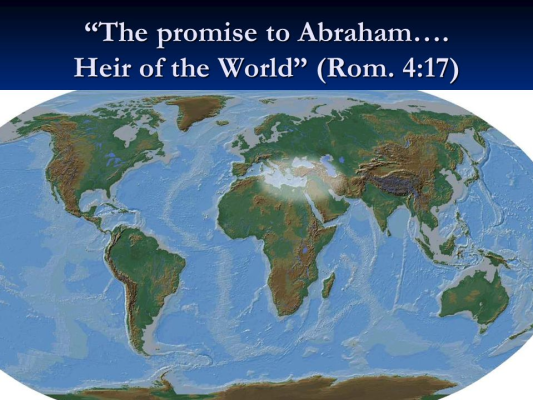
Yahweh promised the Israelites that if they obeyed Him, He would make them the greatest nations ever to exist. The Israelites were destined to be chief among the nations, to be a light shining on a hill, and to rule the world. But near the end times — the time of Jacob’s Troubles — this would change. The treacherous descendants of Cain would gain control over all the Israelite nations and seek to destroy them. Only the European Israelites fit these prophecies. We have ruled the world, but now all our governments have been subverted.
Whilst this prophecy of greatness was originally given to Abraham, the Israelites were given the details in Deuteronomy 28: “And it shall come to pass, if thou shalt hearken diligently unto the voice of the LORD thy God, to observe and to do all his commandments which I command thee this day, that the LORD thy God will set thee on high above all nations of the earth: And all these blessings shall come on thee, and overtake thee, if thou shalt hearken unto the voice of the LORD thy God.”
By David and Solomon’s time, the Israelites had been raised above all nations. But this did not last. They turned away from Yahweh and His law and God dispersed them among the nations. But once the Israelites in Europe had been reconciled to Yahweh through Christianity, they were once again elevated above all nations. This was predominantly in the form of the German Holy Roman Empire, then the British Empire, and currently the American Empire. Although there have always been the nefarious descendants of Cain (bankers) supporting these empires behind the scenes for their own gain, nevertheless, the Israelites have enjoyed the status of world hegemony, as Yahweh promised.
